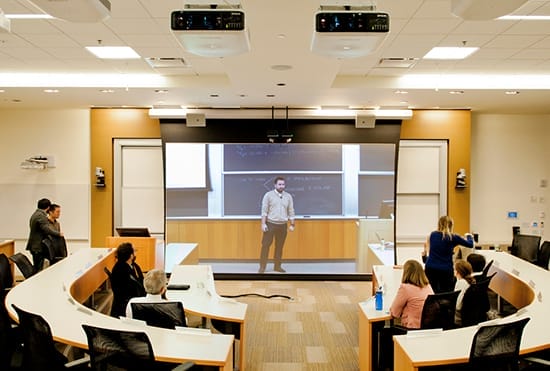Wharton and Cisco have launched a bicoastal technology revolution. Through state-of-the-art classroom systems, they are connecting students and faculty in Philadelphia and San Francisco, seamlessly integrating the learning experience for individuals thousands of miles apart.
“It’s not tough to imagine teachers and students quickly forgetting about all the technology and settling into a classic mode of teaching and learning,” wrote tech journalist Harry McCracken for TIME.com after witnessing it firsthand.
The Cisco Connected Classrooms leverage the tech giant’s TelePresence tools, allowing professors to teach a class comprising students from both coasts. Students sitting in the remote classroom face a screen nearly as wide as the lecture hall that projects a high-definition, life-size image of the presenter beamed from the opposite side of the country. A set of screens at the back of both the local and remote rooms project images of students in the twinned classroom, while screens on either side of each classroom allow presenters to share slides or other content with all participants.
The result is a real-time, interactive experience—professors are able to engage with a class without sacrificing much of their usual teaching style, while students are immersed in a collaborative learning environment.
Following a presentation at the MBA for Executives program at Wharton | San Francisco, students participated in an informal survey. More than half of the class said the session was similar to an in-person experience, and nearly 40 percent said they would be happy to take an entire course in the Cisco Connected Classroom.
Don Huesman, managing director of the Wharton Innovation Group, sees this positive response as extremely encouraging for the technology’s application within the School’s MBA for Executives program. While the physical presence of professors is still an essential part of the MBA experience in San Francisco, the new Cisco Connected Classrooms open up possibilities for more presenters and professors to connect with students on the other side of the country.
“The goal of this is to expand opportunities, not limit them,” says Huesman.
Or as Dean Thomas S. Robertson says, “The Wharton School and Cisco share a passion for innovation, and with this enhanced learning tool, Wharton extends its role as a knowledge-creation leader.”
While Huesman’s team refines it based on early users’ feedback, others at the School have begun to make plans for the Wharton-Cisco Connected Classrooms. A bicoastal student business conference is currently in the pipeline, and Knowledge@Wharton is considering its own possible uses.
—By Abigail Raymond

























